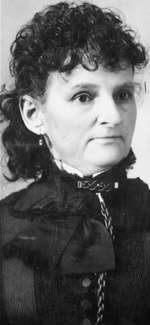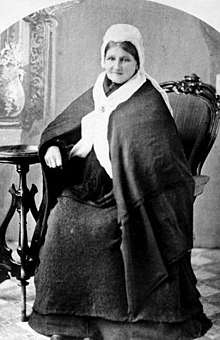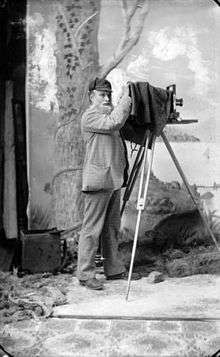Hannah Maynard
Hannah Hatherly Maynard (Bude, 1834 – Victoria, 1918)[1] was a Canadian photographer best known for her portrait work and experimental photography involving photomontage and multiple exposures. She also photographed people using techniques that made them appear as statuary: on columns or posing as if they were made of stone.
Hannah Maynard | |
|---|---|
 | |
| Born | Hannah Hatherly January 17, 1834 |
| Died | May 15, 1918 (aged 84) |
| Known for | Photography |
| Spouse(s) | Richard Maynard |
Early life and career beginnings
She was born in 1834 as Hannah Hatherly, in Bude, Cornwall. Hatherly married in 1852 Richard Maynard, an apprentice boot-maker, and in the same year they emigrated to Bowmanville in Canada West (present-day Ontario), where four of their five children were born.[2] In 1858, Richard joined the exodus of gold-seekers on the Fraser River in British Columbia, and his venture appears to have been profitable.[3] While her husband was out west, Maynard learned the basics of photography, most likely from R & H O'Hara Photographers, in Bowmanville. After selling the boot store, in 1862 the family moved to Victoria on the Colony of Vancouver Island. Richard soon left for the Stikine River to take up placer mining, and it is believed that in 1862 Hannah opened up her first photographic studio, Mrs. R. Maynard's Photographic Gallery.[2] Upon his return home in 1863,[2] Richard found his wife successfully entrenched as a photographer, and by 1864 Hannah had taught her husband the principles of photography while he operated a second boot store.[4]
Hannah and Richard Maynard
In the ensuing years, Hannah and Richard had contrasting photographic specialties. Hannah was best known for her portrait work and at the same time managed darkroom affairs and studio promotion, while Richard focused almost exclusively on outdoor photography.[5] The couple frequently traveled together, in 1875 to purchase photographic equipment in San Francisco, in 1879 on a pleasure cruise around Vancouver Island, and to Banff in the late 1880s.[1][2] Hannah also made a solo trip to the Queen Charlotte Islands sometime in the same decade.[2] Richard continued to travel on his own, to Alaska three times, and throughout British Columbia, sometimes sponsored by government commissions, and in 1892 he traveled to the Pribilof Islands in the Bering Sea.[2] While they published their photographs under separate imprints, it is sometimes unclear in the case of landscape views whether Hannah or Richard was the photographer.[2]
Portraiture and experimental photography

Maynard's portrait work encompassed several different formats following the fashions of the day, cartes-de-visite in the 1860s, cabinet cards in the following decade, as well as larger-sized prints.[3] The Maynard studio is known to have produced forty-three cartes-de-visite of native people, often Victoria street vendors.[3] Maynard was a master of lighting technique, and she was one of the early adopters of line-lit photography to highlight facial features.[2] Her backgrounds were often highly ornamental, utilizing painted backgrounds and elaborate domestic interiors and props.[3]
Starting about 1880, Maynard began to experiment with photomontage in her Gems of British Columbia series which she created each year between 1881 and 1895. Conceived as an annual greeting card to be sent out on New Years to all the mothers of children she had photographed in the preceding year, it was very popular. She cut out the outline of the photograph of each baby or child, and then mounted the images on a pane of window glass and re-photographed the whole.[2][5] In 1884, she began to incorporate the montages of previous years in symbolist patterns, resulting in compositions that included up to several thousand individual photographs.[2] Her Gems of 1885 was published and praised by the St. Louis and Canadian Photographer in 1886, bringing Maynard a measure of recognition throughout North America.[5]
Beginning in 1883 Maynard was struck by personal tragedy, with the death of her 16-year-old daughter Lillian of typhoid fever, followed in later years by another daughter Emma and daughter-in-law Adelaide, and some of her photographs began to take on the aspect of a memorial to the departed.[3] It was also in this period that she took an interest in seances and Spiritualism.[2][3] She began in the 1880s to create a type of photograph described by her as "Living Statuary" or "Statuary from Life", the sitter often appearing as a bust on a pedestal.[2] Her experimentation developed further into the realm of multiple exposure, and some photographs show as many as four or five likenesses of Maynard, often engaged in different tasks, or in one notable image, holding a single garland of flowers.[2][3] A selection of her double and multiple exposure photographs were published in the St. Louis and Canadian Photographer in 1894.[2] Another difficult technique that Maynard pursued was that of bas-relief, which involved the embossing of a photograph.[2] Around 1897, Maynard discontinued her investigations of trick photography.[2]
Later years and legacy
Between 1897 and 1903, while continuing her studio portraiture, Maynard was the official photographer of the Victoria Police Department, producing mug shots as required.[2][3] In 1907 her husband Richard died, and in 1912 she retired, selling her photographic equipment to a local Chinese photographer.[1][2] She summarized her achievement by stating that "I think I can say with confidence that we photographed everyone in the town at one time or another."[6] Maynard died in 1918 in Victoria at the age of 84. She is buried in Ross Bay Cemetery.[2]
A play based on the life of Maynard, Be Still, premiered at Richmond's Gateway Theatre on March 1, 2001 and opened at Victoria's Belfry Theatre on March 14 of the same year.[1]
Gallery
 Verso of carte-de-visite showing studio logo of Hannah Maynard. ca. 1868-1878
Verso of carte-de-visite showing studio logo of Hannah Maynard. ca. 1868-1878 Lady Amelia Connolly Douglas. 1862 (wife of Governor James Douglas)
Lady Amelia Connolly Douglas. 1862 (wife of Governor James Douglas) Captain Jack and his wife. c. 1868 (a Kwakiutl couple)
Captain Jack and his wife. c. 1868 (a Kwakiutl couple) Laura Lillian Maynard. 1874
Laura Lillian Maynard. 1874 John Wallace Crawford. c. 1878
John Wallace Crawford. c. 1878 Bust of a young girl. c. 1882[2]
Bust of a young girl. c. 1882[2] Girl holding a bird. Living Statuary series. 1884
Girl holding a bird. Living Statuary series. 1884 Gems of British Columbia. 1885
Gems of British Columbia. 1885 Ah Foo. c. 1885
Ah Foo. c. 1885 Unidentified woman. Example of line-lit photography. c. 1890
Unidentified woman. Example of line-lit photography. c. 1890 Hannah Maynard cycling. c. 1892
Hannah Maynard cycling. c. 1892 Richard Maynard. 1890s
Richard Maynard. 1890s Self-portrait with multiple exposure. c. 1893
Self-portrait with multiple exposure. c. 1893 Likenesses of Hannah Maynard with garland. c. 1895
Likenesses of Hannah Maynard with garland. c. 1895 Belle Adams (Victoria Police Department photo). 1898
Belle Adams (Victoria Police Department photo). 1898
Notes
- Mattison, David. "Maynard, Hannah Hatherly". Camera Workers, The British Columbia Alaska & Yukon Photographic Directory, 1858-1950. Archived from the original on 29 June 2016. Retrieved 15 December 2019.
- Wilks, Claire Weissman. The Magic Box: The Eccentric Genius of Hannah Maynard. Exile Editions, Toronto, 1980. ISBN 0-920428-34-7
- Watson, Petra Rigby. The Photographs of Hannah Maynard: 19th Century Photographs. Exhibit Catalogue. Charles H. Scott Gallery, July 17 – August 23, 1992.
- Palmquist, Peter E.; and Thomas R. Kailbourn. Pioneer Photographers of the Far West: A Biographical Dictionary 1840-1865. Stanford University Press. Stanford, California, 2000. ISBN 0-8047-3883-1
- Williams, Carol J. Framing the West: Race, Gender, and the Photographic Frontier in the Pacific Northwest. Oxford University Press, New York, 2003. ISBN 0-19-514630-1
- Victoria Daily Colonist, September 29, 1912. Cited in Watson, 1992.
External links
- Hannah Hatherly Maynard photographs at Wikimedia Commons